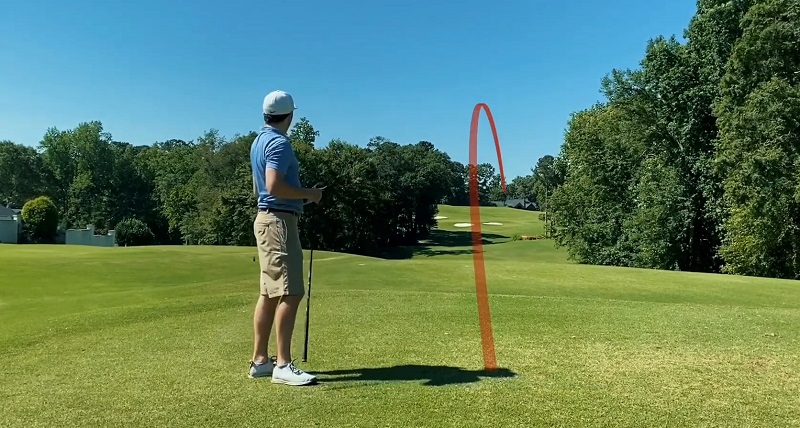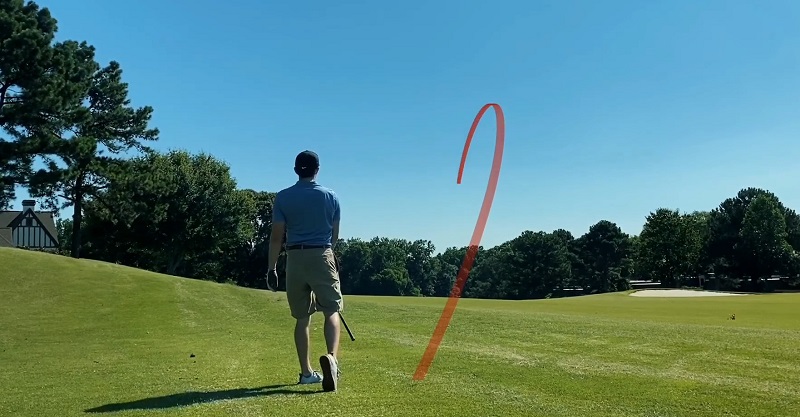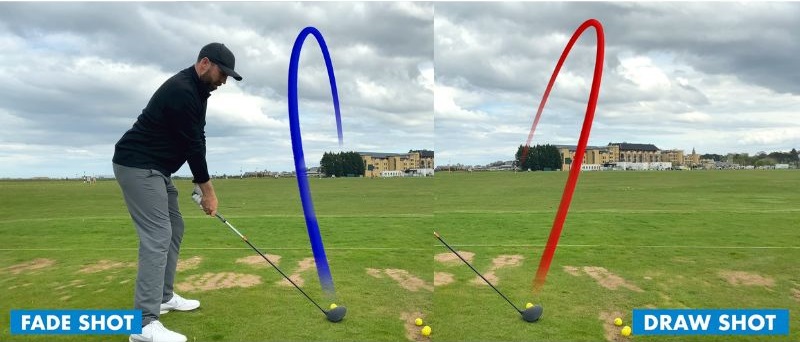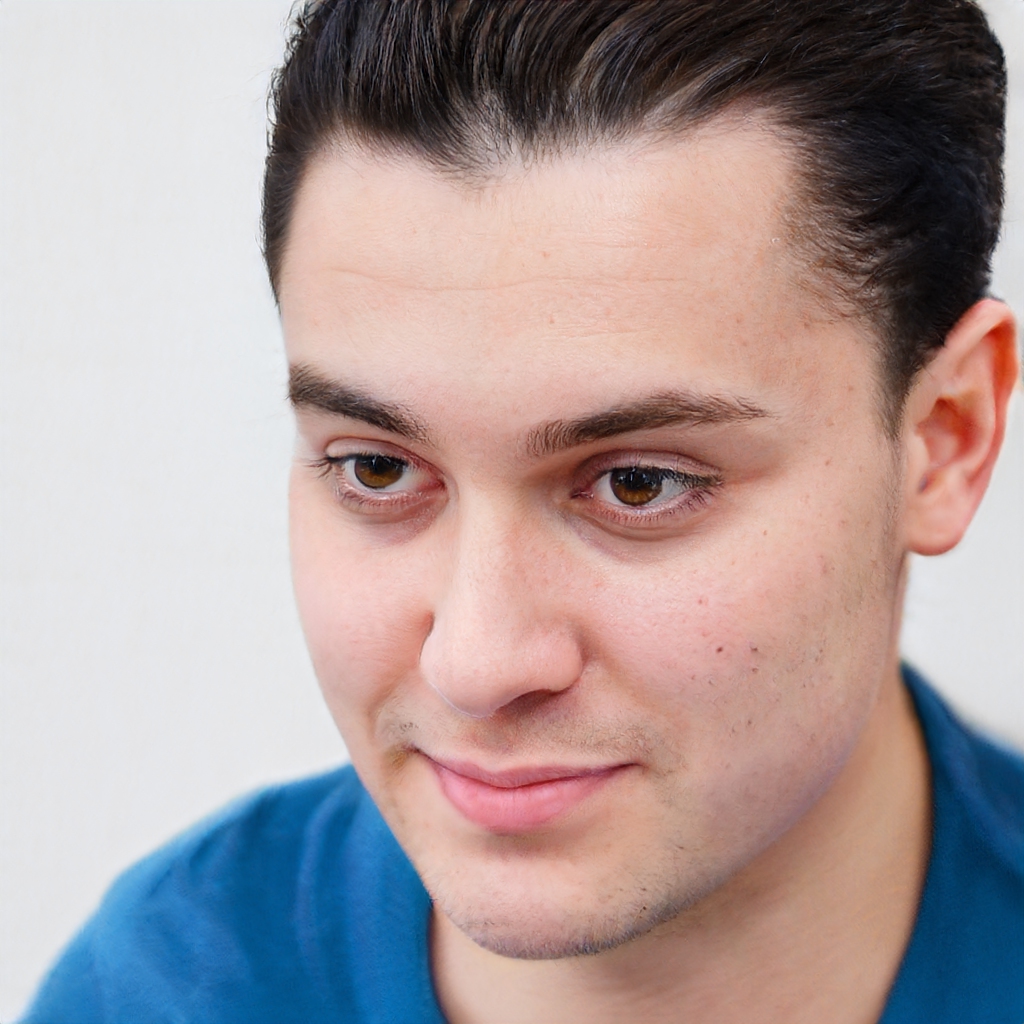Golfers of all levels must understand the difference between golf draw and fade shots to hit their golf balls with precision. The golf swing technique for each shot is different, as is the draw vs fade in golf strategies. Golf club selection also plays a role in determining which type of shot you should use in any given situation. Knowing when to use a golf fade or draw will give you an advantage on the course and help improve your game overall.
This article will discuss everything you need to know about draws and fades in golf, including shot shape, pros and cons, and when to hit them. With this knowledge under your belt, you’ll be able to make more informed decisions on the course that will lead to better results!
Read more: Closest To The Pin In Golf: Meaning, Rules & How It Work
What Is A Fade In Golf?

A fade is a shot that starts off left to right (for a right-handed golfer), with the ball eventually coming back toward the starting point of impact. The flight path of a fade resembles an arch and is generally used to steer away from hazards or when trying to work around trees. A fade can also be useful in controlling distance. A fade requires a slight outside-in swing path, with the face of the club slightly open at impact and an increased amount of spin on the ball. This will cause the left to right movement at take off, before eventually coming back towards its starting point.
It is important to note that if a golfer has too much spin on the ball, it can cause excessive fade or even a slice. Professional golfers are highly skilled in controlling spin and trajectory and have the ability to shape their shots as needed.
Pros And Cons Of Using Fade Shots
The fade shot has gained popularity among professional golfers in recent years due to its ease of control and strategic advantages. This shot provides a higher trajectory and softer landing, especially when players must navigate a tucked flag or a course with fast, firm conditions.
However, the fade shot does have its drawbacks, mainly in the distance department. The average fade tends to spin more and carry slightly less distance, leading to a shorter overall distance due to minimal rollout.
Despite this shortcoming, the world’s top golfers view this trade-off as worthwhile, opting to sacrifice a bit of yardage for greater accuracy and proximity to the flag. While this may be a viable strategy for top-level golfers, the average 15-handicap player may not find the same benefits from employing the fade shot in their game.
How To Hit A Fade?
Hitting a fade requires proper technique and practice. In order to hit a controlled and consistent fade, the clubface should be square at impact and the path of the swing should travel from outside in across your body. To achieve this, check your stance:
• Make sure you are standing in an open stance, with your feet slightly wider than shoulder-width apart.
• Ensure that the ball is positioned in line with your left heel (for right-handers).
• Adjust your grip to a neutral position by rotating your hands clockwise away from the target. This will allow for more rotation of your wrists and arms during the swing.
Once you have your setup and grip sorted, it’s time to practice swinging. Remember that a fade shot is all about control, so focus on making a smooth motion. Start with your shoulders rotating away from the target as you initiate the backswing. On the downswing, move your arms and wrists downward together and across your body while keeping your hands slightly ahead of the club head. As you reach impact, ensure that your clubface is slightly open at impact and pointing at the target as you hit through the ball to complete the shot.
If your fade shots are still going too far right or left of your desired target, try adjusting your grip pressure or stance accordingly until you achieve the desired results. With enough practice and patience, you can hit consistent fades with ease!
What Is A Draw In Golf?

A draw is the opposite of a fade and is used by golfers to their shot from right to left (for a righthanded golfer). It has many of the same as a fade but works in reverse. To hit a draw, the golfer needs to make an inside-out swing path with slightly more clubface loft and less spin on the ball. This will cause the shot to hook slightly in the opposite direction of a fade, with the ball eventually coming back toward its starting point. Professional golfers have mastered controlling trajectory to shape their shots as needed and can control the draw or fade of their shots depending on the situation.
While both a fade and draw can be used to great effect when the situation calls for it, it is important to know how to control the ball and have an understanding of the different elements involved.
Pros And Cons Of Using Draw Shots
The allure of the draw shot in golf is undeniable, given that it offers a lower, more penetrating ball flight that often results in greater distance than its counterpart, the fade.
This shot’s topspin allows for a gratifying rollout, making it particularly useful on open or links-style courses that aim to keep the ball low and close to the ground.
However, mastering the draw can be challenging, as the increased distance can cause wider shot dispersion and even lead to unintentional hooks, putting the ball in a precarious position.
As a golfer advances in skill, learning to strategically employ both draw and fade shots according to the demands of the course can provide a significant edge over competitors who remain reliant on a single shot shape.
How To Hit A Draw?
Hitting a draw requires you to use the same technique as hitting a fade, but in reverse. To hit a controlled and consistent draw, start with your stance:
• Make sure you stand in an open stance, with your feet slightly narrower than shoulder-width apart.
• Ensure that the ball is aligned with your right heel (for right-handers).
• Adjust your grip to a neutral position by rotating your hands counterclockwise toward the target. This will allow for more rotation of your wrists and arms during the swing.
Once you have your setup and grip sorted, practice swinging in reverse of the fade technique: Start with your shoulders rotating towards the target as you the backswing. On the downswing, move your arms and downward together and away from your body while keeping your hands slightly behind the club head. As you reach impact, ensure that your clubface is slightly closed at impact and pointing at the target as you hit through the ball to complete the shot.
If your draw shots are still going too far right or left of your desired target, try adjusting your grip pressure or stance accordingly until you achieve the desired results. With enough practice and patience, you can hit consistent draws with ease!
When To Use Draw Or Fade In Your Golf Game?
Deploying these shot variations at the right moments can help navigate around obstacles and optimize the positioning on the fairway or green.
With its right-to-left curvature for right-handed players, a draw can be advantageous on dogleg-left holes or when approaching a pin tucked behind a bunker on the left. It also effectively navigates obstacles, such as trees or bunkers.
Meanwhile, a fade, which moves from left to right, is equally crucial in dogleg-right holes or circumventing hazards on the right side. It also provides better control, accuracy, and a softer landing on the greens.
By mastering the art of executing both draw and fade shots, you will be better equipped to approach complex golf setups and demonstrate higher expertise. These strategic shots help you save strokes and exemplify a more refined understanding of golf course management.
Which Type Of Shot Is More Difficult To Execute?

The debate on which shot is more difficult to execute largely depends on the golfer’s skill level and natural ball flight tendencies.
Most amateurs and weekend players find the draw shot more challenging, as it requires a higher degree of finesse and consistency in the swing path, whereas professional golfers often find the fade easier to control, particularly under pressure situations.
Nevertheless, the true hallmark of a proficient golfer is the ability to choose and skillfully execute both types of shots, demonstrating versatility and adaptability on the course.
Golf Club Selection For Golf Draws And Fades
Mastering the art of golf club selection for executing perfect draws and fades is crucial in consistently conquering the golf course. Both shots have distinct characteristics and choosing the right clubs significantly impacts their execution.
Embracing a professional mindset, a golfer must understand each club and be able to adapt their selection based on factors such as distance, wind direction, and pin placements.
As golfer hones their skill set, they will begin to instinctively know when to reach for the long irons to shape a draw around a dogleg or utilize the higher-lofted clubs for a soft landing fade into a tight pin position.
Developing this expertise in golf club selection for draws and fades will ultimately lead to enhanced strategic play and improved scores.
Conclusion
Golf draw vs fade shots is a golfer’s best friend in golf course strategy. Golfers should experiment with golf fade vs draw shots to understand better how golf draw and fade shots work and which type of shot works best for their golf game. With practice and the right golf swing mechanics, golfers can gain the confidence to hit golf draw or fade shots with precision.
Knowing when and how to use fade and draw in golf can be the difference in golfers achieving their goals or having an unsuccessful round of golf. Using golf fade and draw shots strategically can help golfers gain a golf course advantage and make golf more enjoyable.
FAQs
Is It Better To Fade Or Draw In Golf?
The answer to this question depends on the shot you are attempting. Both fade and draw shots can be beneficial in certain circumstances and which one you should use depends on your skill level and the type of shot you are attempting. Generally speaking, a draw is a controlled shot that results in minimal.
What Golf Club Should I Use To Hit A Draw Or Fade?
To achieve these shots, consider utilizing a longer club, such as a low iron club or a fairway wood. These clubs often have a lower center of gravity and tend to promote additional side spin on the golf ball.
Is It Better To Draw Fast Or Slow?
Golfers should experiment with golf draw and fade shots to determine which golf draw vs fade shot works best for their golf game. Generally, golfers should use a slower golf swing to hit golf draws, while golfers should use a faster one to hit golf fades.
Do I Get More Distance With A Draw Or Fade?
Golfers will typically get more distance with golf draws, as golf draws allow golfers to hit the golf ball farther down the golf fairway. Also, golf fade shots can be used to hit golf balls around golf course hazards and flags.


